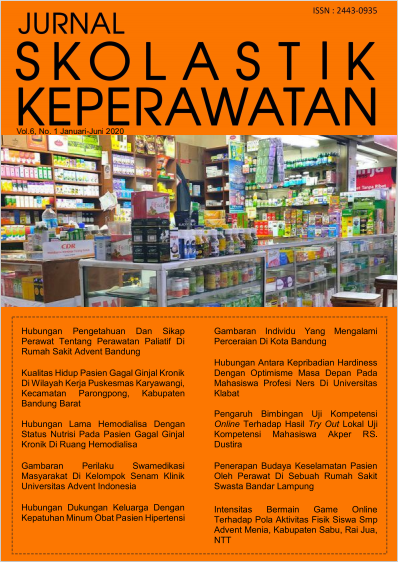PENERAPAN BUDAYA KESELAMATAN PASIEN OLEH PERAWAT DI RUMAH SAKIT BANDAR LAMPUNG
Keywords:
Budaya keselamatan pasien, Perawat, PenerapanAbstract
Pendahuluan: Pemberi layanan kesehatan harus mengutamakan keamanan pasien sebagai perioritas. Tujuan:Untuk mengkaji penerapan budaya keselamatan pasien olehperawat sehingga hasilnya dapat dijadikan acuan dalam meningkatkan kualitas keperawatan. Metode: Penelitian descriptive comparative cross sectional designdilakukan kepada 50 responden perawatdari berbagai departemendengan menggunakan instrument Hospital Survey of Patient safetyCulture (HSOPCS) yang terdiri dari 12 dimensi. Uji statistic Mann Whitney digunakan untuk menganalisaperbedaan penerapan antara kelompok perawat. Hasil: Penelitian ini menunjukkan bahwa rerata respon positif dari 12 dimensi yang diberikan oleh staf pelaksana (74,6%),tewrdapat 5 dimensi yang perlu di tingkatkan.Untuk para perawatincharge mempunyai nilai rata-rata (79,4 %)dan masih ada 4 dimensi yang perlu ditingkatkan.Pada kelompok head nursenilai rata-rata respon positif dari 12 dimensiadalah 76,7% dan masih terdapat 5 dimensi yang perlu ditingkatkan.Kelompok kepala ruangan nilai rata-rata respon positif dalam 12 dimensiadalah 88,6% dan terdapat 1 dimensi yang perlu ditingkatkan. Terdapat perbedaan yang signifikan dalam pelaksana budaya keselamatan pasien antara staf inchargedengnhead nursedan dengankepala ruangan. Diskusi: Dengan meningkatkan penerapan budaya keselamatan pasien diharapkan perawat dapat memberikan perawatan yang komprehensif, berbasis buktidan berpusat pada kebutuhan pasien sehingga keselamatan pasien dirumah sakit dapat tercapai.
Downloads
References
Undang Undang Republik Indonesia no 44 tahun 2009 tentang rumah sakit
Charles, K, McKee, L., & McCann, S. (2011), April 16). A Quest For Patient Safety Culture: Contextual Influences on Patient safety Performance, J Health Serve Res Policy, 57-64
Carthney, J., & Clarke, J. (2010). Implementing Human Factors in Healthcare. How to Guide
Cooper, C., & Clarke, S. (2003). Managing the Risk of Workplace Stress. London: RoutledgeCAHRQ Hospital Survey on Patient Safety Culture: user guide, 2016
Bates DWI, Boyle DL, Vander Vliet MB, Schneider J, Leape L. relationship Between Medication Errors and Adverse Drug Event. J Gen Intern Med. 1995 April; 10(4):199-205.s.
Biaggi, P., Peter, S., & Ulich, E. (2003). Stressor, Emotional Exhaustion, and Aversion to Patients in Residents and Chief Resident, Swiss Medical Weekly, pp.339-346
Bower,P., Campbell, S., Bojke, C., & Sibbald, B. (2003). Team Structure, Team Climate and Quality of Care in Primary Care an Observational Study. Quality anf Safety in Health care, 273-279
Brown, D. S., & Wolosin, R. (2013). Safety Culture Relationships with Hospital Nursing Sensitive Metrics. Journal for Healthcare Quality, 61-74.
Depkes RI. (2008). Panduan Nasional KeselamatanPasien Rumah Sakit (Patient Safety): Utamakan Keselamatan Pasien. Jakarta: Depkes RI.
El-jardarli, F., Dimassi, H., Jamal, D., Jaafar, M., & Hemadeh, N. (2011). Predictors and Outcomes of Patient Safety Culture in Hoepital. BMC Health service Researsh,9
Hawkins, C. T., & Flynn, L. (2015). Patient Safety Culture and Nurse-Reported Adverse Events in Outpatient Hemodialysis Units. Research and Theory for Nursing Practice: An International Journal, 53-65.
Indonesia, M. K. R. (2017) Peraturan menteri kesehatanRepublik Indonesia Nomor 11 Tahun 2017 tentang Keselamatan Pasien, Peraturan Menteri Kesehatan Republik Indonesia Nomor 11 Tahun 2017 Tentang Keselamatan Pasien Dengan. Indonesia. Available at: jdih.baliprov.go.id/produkhukum/download/12274
Kane, Robert,L., Shamliyan, T., Mueller, C.,Duval & Wilt, T.J. nurse Staffing and Quality of Patient Care: Evidence Report/Technology Assessment, no 151. Prepared for Agency for Health care Research and Quality (AHRQ). Rockville, MD: March, 2007; Pub no 07-E005;p.6. http://www.ncbl.nlm.nih.gov/pubmed/1776420
Kim, I. S., Park, M. J., Park, M. Y., Yoo, H., & Choi, J. (2013). Factors Affecting the Perception of Importance and Practice of Patient Safety Management among Hospital Employees in Korea. Asian Nursing Research, 26-32.
KKP RS. (2011). Laporan Insiden Keselamatan Pasien. Jakarta: KKP RS.
Kemenkes RI. (2011). Permenkes RI No.1691/Menkes/VIII/2011 tentang Keselamatan Pasien Rumah Sakit. Retrieved 11 23, 2015, fromhttp://202.70.136.86/bprs/uploads/pdffFiles/21%20PMK%20No.%201691%20tt g%20Keselamatan%20Pasien%20Rum ah%20Sakit.pdf
Komite Keselamatan Pasien Rumah Sakit (2015) Pedoman Pelaporan Insiden Keselamatan Pasien (IKP), Komite Keselamatan Pasien Rumah Sakit. Jakarta. Available at: www.pdpersi.co.id.
Sora, J., & Nieva, V. (2003). Hospital Survey on Patient Safety Culture. Quality and safe Health care. Hospital
Thomas, E., Sexton, J., Neilands, T., Frankel, A., & Helmreich, R. (2002). The effect of Executive Walk Rounds on Nurse Safety Climate Attitude: A randomized Trial of Clinical Units. BMC Health Serv Res
Yilmaz, Z., & Goris, S. (2015). Determinationof the patient safety culture among nurses working at intensive careunits. Pakistan Journal Of Medical Science, 597-601.WHO, (2014, June) 10 Fact On Patient Safety.
Downloads
Published
How to Cite
Issue
Section
License
Copyright (c) 2021 Ernawaty Siagian

This work is licensed under a Creative Commons Attribution-NonCommercial-ShareAlike 4.0 International License.
Authors who publish with this journal agree to the following terms:
- Authors retain copyright and grant the journal right of first publication with the work simultaneously licensed under a Creative Commons Attribution-NonCommercial-ShareAlike 4.0 International (CC BY-NC-SA 4.0) that allows others to share the work with an acknowledgment of the work's authorship and initial publication in this journal.
- Authors are able to enter into separate, additional contractual arrangements for the non-exclusive distribution of the journal's published version of the work (e.g., post it to an institutional repository or publish it in a book), with an acknowledgment of its initial publication in this journal.
- Authors are permitted and encouraged to post their work online (e.g., in institutional repositories or on their website) prior to and during the submission process, as it can lead to productive exchanges, as well as earlier and greater citation of published work (See The Effect of Open Access).









